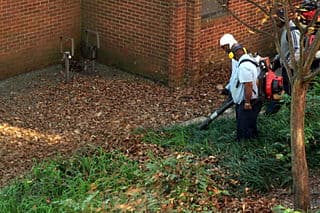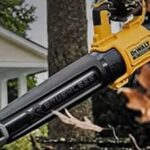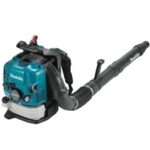As an Amazon Associate, this site earns commissions from qualifying purchases. For more information click here.
There are many types of leaf blowers, but what they all share in common is that it must never smoke when in use. Turn the engine off the moment it starts to do so, because it means there is a problem that needs your immediate attention. In this post you will discover the most common causes and how to fix them.
A damaged piston ring, dirty muffler, cylinder issues or leaking fuel tank can make a leaf blower smoke during and after use. If the carburetor is clogged it will not be able to generate the right fuel ratio and generate a lot of smoke.
Leaf Blower Smoke Quick Guide
If you are in a hurry, use this table as reference. This is a quick overview only, and if you want more details, please read on.
| Smoke Color | Possible Causes | Solutions |
|---|---|---|
| Blue or white | Too much oil Oil or air leaks Damaged cylinder Crankcase sealing problem Dirty piston rings | Let excess oil run out Fix the oil or air leak Replace the cylinder Split or replace the crankcase Clean or replace the piston ring |
| Black | Too much gas in the fuel mixture Dirty muffler or air filter Damaged or dirty carburetor | Use a leaner fuel mix Clean or replace the muffler and/or air filter Clean or replace the carburetor |
In general, blue or white smoke can be attributed to extraneous amounts of burning oil. Black smoke usually means the leaf blower is burning a greater amount of fuel than air.
In both cases these can be caused by dirty or damaged components. Now we can take a look at what those possible causes are and how to fix them. Since you have a general idea of what the problems and solutions are like, you can explore each one in more detail.
Too Much Oil
The most likely reason why your leaf blower smokes is there is too much oil. In some cases the extra oil leaks out, burns and generates white smoke. Use the following fix for your Husqvarna 150BT and other leaf blowers.
Solution. Just let your leaf blower run and burn the oil. After a while the excess fluid will be gone and the smoke will disappear.
Let the engine run until the oil burns itself out. Shutting it off and restarting will not solve it until the extraneous oil is gone. How long this takes depends on how much excess is in the tank. If the white smoke persists, try the other solutions here.
If you did already and the engine won’t start, empty the tank and fill it with new fuel. Follow your owner’s manual for instructions on the mixture ratio.

Wrong Fuel Mix Ratio
Two-cylinder gas leaf blowers use a mixture of gas and oil. The ratio has to be exactly what the manufacturer recommends. If you made a mistake the engine will not run properly. Even if it starts you will smoke emerging from the blower.
If the fuel is old, replace it immediately. Its efficiency will wear out soon and you might as well replace it. All kinds of problems – including smoke and stalling – can arise from using old fuel.
Solution. Turn your leaf blower off and empty the fuel tank. Prepare a new fuel mix and make sure the ratio is correct. Try the leaf blower again and check if there is any smoke left.
Most 2-cylinder leaf blower engines use a 40:1 ratio for gas and oil. A gallon of gas for 3.2 oz. of engine oil is a good mix. Make sure the fuel is for two-cylinder engines before proceeding.
Crankcase Sealing Damage
Most leaf blower smoking issues have something to do with the engine. An example of this are problems on the crankcase seals. If there is damage around this area, smoke could arise from the engine.
Solution. Sealing problems usually means fuel has entered the crankcase. To solve this you need to divide the crankcase into two. You should also inspect the cylinder and piston rings for possible damage.
Splitting the crankcase requires some effort. If you are not comfortable doing this you can take the leaf blower to a repair shop and have a specialist do it for you.
Leaking Fuel Tank
Fuel tanks have a seal so fuel goes straight into the cylinder. Due to wear and tear, the carburetor develops cracks or leaks. If fuel seeps out and gets into the engine, the leaf blower will start to smoke.
Solution. Turn your leaf blower. Check the gasket on top of the intake manifold as that is where most leaks originate. You should also inspect the carburetor elbow connectors and fuel hoses.
Repair the leak or replace those parts if they are worn out. Due to differences in manufacturing, location of these components vary. Consult your owner’s manual for information about the carburetor.
Dirty Muffler
The muffler is responsible for reducing the noise the engine makes it starts. Whenever the machine starts, gases come out of it, leaving carbon behind. Over time the carbon builds up and ends up producing a lot of smoke.
Solution. Cleaning a dirty muffler will solve the problem. Prepare soapy water and get a clean piece of cloth. Wipe the carbon and dirt from the inside and outside of the exhaust. Use a brush if necessary to remove the dirt in the interior.
You may have to scrub repeatedly to remove the dirt. You may also have to use a degreaser if the grime refuses to come off.
Damaged Cylinder
The cylinder contains the piston ring and plays an important role in how leaf blowers work. If you see white smoke there could be an issue with the cylinder. This can happen if the leaf blower engine is flooded or the piston ring is damaged. If compression is low due to piston ring damage, smoke will ensue.
Solution. Cylinder problems are often caused by not enough lubrication or dirt. Inspect the cylinder and clean as necessary. Lubricate the cylinder and try the leaf blower again.
Replace the Carburetor
The carburetor is responsible for combining fuel and air to generate gas. If the leaf blower refuses to idle, the engine stalls or you see smoke, this component is probably damaged. If the fuel tank is filled but it refuses to start, there is a problem with the carburetor.
The following instructions show you step by step how to replace a leaf blower carburetor. These instructions assume you are familiar with engine components and follow all safety precautions. You will need:
- Work gloves
- Needle nose pliers
- Torx screwdriver
This process works with leaf blower carburetors by Husqvarna, Craftsman, Poulan, Troybilt, Weed Eater and MTD. If your leaf blower is by a different brand, please check the manual for information on the carburetor. If you need a rebuild kit, we suggest the Qazaky 3-pack carburetor rebuild kit. It contains a lot of commonly used parts for Ryobi, Craftsman, Poulan Homelite and other well-known brands.
Step 1. Turn your leaf blower off and place it in a well-ventilated location. Take the fuel cap off. Empty the fuel tank.
Step 2. Disconnect the wiring off the spark plug. This is a safety measure to ensure the leaf blower does not suddenly start.
Step 3. Unscrew the air filter cover. Put the screws in a safe location and lift the air filter cover off.
Step 4. Once you are done with step 3 you can access the carburetor. Remove the screws on the carburetor mount.
Step 5. Pull the air box out. The next step is releasing it from the choke lever and throttle. Set the carburetor aside.
Important: you have to memorize the setup of the carburetor fuel lines as you will need this information later. Once you have noted the fuel line layout, you can take the carburetor out.
Step 6. Set the fuel lines on the connections of your new carburetor. Place the carburetor into the air box. Make sure the choke levers and throttle are in the correct configuration.
Set the carburetor so that it is on the engine side. Put the mounting screws back on. Secure them tight.
Step 7. Place the air filter cover on the carburetor. Secure it with the cover screws.
Step 8. Reconnect the wire to the spark plug. Refill the fuel tank and start the leaf blower.
How to Clean and Rebuild a Carburetor
If you prefer to clean and rebuild the carburetor, follow these steps. These instructions work for Husqvarna, Craftsman, Poulan, Troybilt, Weed Eater and MTD leaf blowers.
Step 1. Remove the carburetor from the leaf blower. Follow steps 1 to 5 in “how to replace a leaf blower carburetor” above. When you are done with step 5, follow the instructions below.
Step 2. Take off the carburetor top cover with the primer bulb.
Take off the primer bulb, gasket and diaphragm off the top cover, in that order. If the primer bulb is damaged or gotten stiff, replace it.
Step 3. Remove the screws on the carburetor bottom cover. Take the cover and diaphragm off and separate the two.
Step 4. Note the configuration of the hinge pin, spring and lever. Take off the screw holding the fuel and needling lever. Set the parts aside for now.
Step 5. Clean the carburetor with canned air and carburetor cleaner. Pay close attention to the jets and ports in particular. Let it dry for 15 minutes minimum.
Step 6. Put the needle and lever back on and fasten the screw. Reinstall in order, the gasket, diaphragm and cover.
Step 7. Put the carburetor back in the air box and position the choke levers and throttle correctly.
Step 8. Put the carburetor in the engine side. Put the screws back on. Put the air filter cover back on.
Step 9. Reconnect the spark plug wiring
You are done. The only thing left to do is reconnect the spark plug wire, fill the fuel tank and start your leaf blower.
Damaged Piston Ring
A damaged piston ring can prevent your leaf blower from running. The piston covers the gap between the cylinder wall and the piston. If there is a problem with the piston ring the compression is reduced and makes it hard for the engine to start.
Solution. The easiest fix is to just replace the piston ring. Once you get to the cylinder you can take the piston ring off. You should also look for carbon deposits in this area. If you see smoke coming from the blower when it revs up but dissipates shortly, it is due to the carbon buildup. Cleaning or replacing the piston ring will fix it.

I love the outdoors and all the tools for maintaining gardens, yards and lawns. The only thing I am more passionate about is sharing what I know about garden and outdoor equipment.


